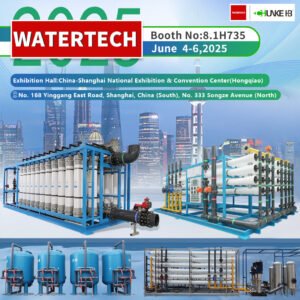Industrial Reverse Osmosis Plant
We will introduce CHUNKE industrial Reverse Osmosis Plant to get clean, safe and pure water for your application, process and business.
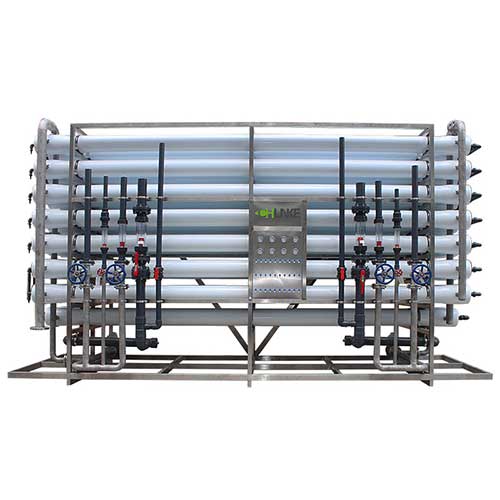
As an industrial facility operator, you likely rely on ultrapure water for processes throughout your plant. For high-volume needs, industrial reverse osmosis systems can produce the quantities of highly purified water required. These massive filtration systems are designed to generate consistent, contaminant-free water at flow rates up to millions of gallons per day. By leveraging advancements in membrane technology and automation, today’s industrial RO systems can achieve new levels of energy efficiency, reliability, and customization to suit the specific needs of your operations. Whether for use as boiler feedwater, ingredient water in food and beverage production, or makeup water for cooling towers, an industrial reverse osmosis system may provide the solution for your high-volume ultrapure water demands.
How Industrial Reverse Osmosis Plants Work
To produce ultrapure water on an industrial scale, reverse osmosis (RO) systems are used. RO plants push water through semi-permeable RO membranes that remove ions, molecules and larger particles.
RO systems typically consist of:
Pretreatment – Filters remove suspended solids and contaminants that could clog the RO membranes. Options include sand filters, cartridge filters and ultrafiltration.
High-pressure pumps – Increase the feedwater pressure to push it through the RO membranes. Multiple stages of pumping are often used.
RO membranes and membrane housings – The heart of the system. Membranes selectively allow water to pass through while blocking other substances. Multiple membranes are bundled together in a membrane housing.
Piping, valves and controls – Transport the feedwater, RO permeate and RO concentrate. Valves and controls regulate flows and pressures.
Post-treatment – Further purify the RO permeate. Steps may include ion exchange, ultraviolet disinfection, and distillation.
RO plants can produce 10,000 to over 100 million gallons of ultrapure water per day to meet industrial needs. When designed, installed and operated properly by trained professionals, RO systems are an efficient and cost-effective solution for large-scale production of high-purity water. By following standard operating procedures and performing regular maintenance, RO plants can provide a long-term source of ultrapure water for industrial operations.
CHUNKE Industrial Reverse Osmosis Plant
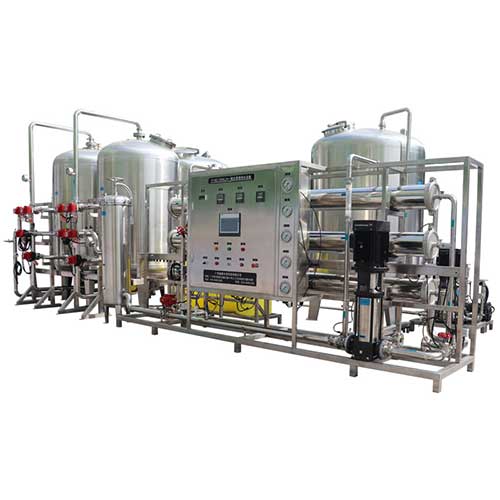
Industrial Reverse Osmosis Plant for Tap Water
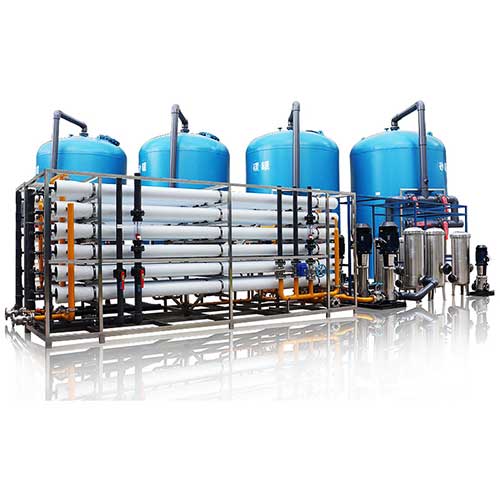
Industrial Reverse Osmosis Plant for Brackish Water
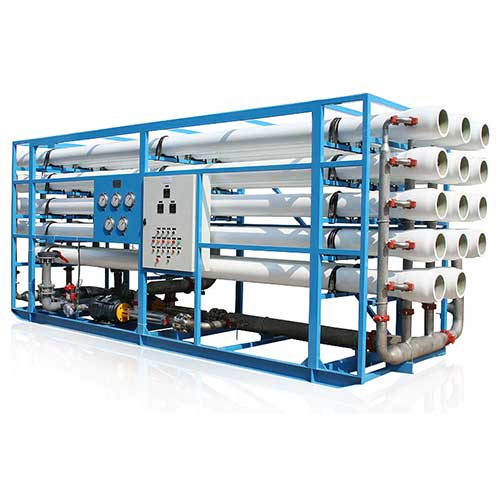
Industrial Reverse Osmosis Plant for Sea Water
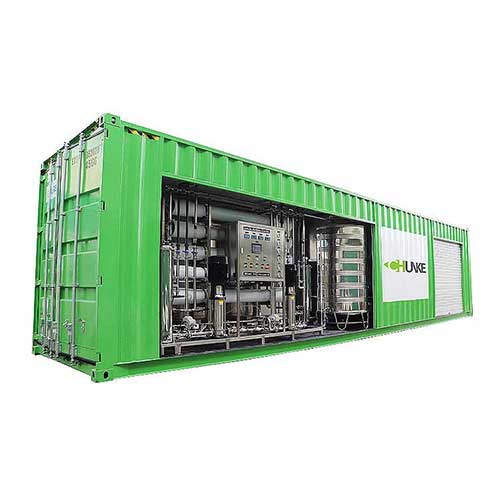
Containerized Reverse Osmosis Plant
Types of Reverse Osmosis Membranes Used in Industrial RO Systems
Industrial reverse osmosis (RO) systems utilize specialized membranes to filter impurities and contaminants from water at high volumes. There are two primary types of membranes used: cellulose acetate (CA) and thin-film composite (TFC) polyamide membranes.
CA membranes, made of cellulose acetate polymer, were the first developed and are more affordable, but less efficient. TFC polyamide membranes are composed of a polyamide layer on top of a microporous support layer, making them more durable and capable of higher rejection rates of total dissolved solids (TDS) and other contaminants.
The majority of industrial RO systems now utilize TFC polyamide membranes given their superior performance and longevity. The specific type of TFC membrane, such as high-rejection or low-energy, depends on the needed level of purity and amount of dissolved solids in the feedwater. Systems requiring very high purity water, below 1 part per million of TDS, will use high-rejection TFC membranes. For feedwater with lower TDS, low-energy TFC membranes can achieve suitable purity while requiring less energy.
In selecting membranes, system operators must consider feedwater quality, product water requirements, and operating costs. TFC polyamide membranes, though initially more expensive, frequently offer the best balance of high performance, durability, and life cycle cost for industrial RO systems producing ultrapure water. By optimizing membrane choice and system design, operators can achieve maximum productivity and lowest cost of operation.
Components of an Industrial Reverse Osmosis System
An industrial reverse osmosis (RO) system contains several key components to produce ultrapure water on a massive scale.
Membrane Modules
At the heart of an RO system are membrane modules containing semi-permeable RO membranes. Feed water is pumped at high pressure through these membranes, which remove ions and larger molecules. RO systems typically use multiple membrane modules in series to achieve high purity levels.
Pumps
RO systems require high-pressure pumps to push feed water through the RO membranes. Centrifugal pumps are commonly used and can generate pressures of up to 1,200 psi. The number and size of pumps depend on the volume of feed water and level of purity needed.
Pretreatment Equipment
Before reaching the RO membranes, feed water goes through pretreatment steps to remove particles and chemicals that could damage the RO membranes. Pretreatment often includes filtration, softening, and dechlorination. Systems may also have equipment for pH adjustment and antiscalant injection.
Permeate and Concentrate Piping
Piping carries the purified permeate water and concentrated reject water (concentrate) away from the RO system. The permeate pipe transports ultrapure water to its point of use. The concentrate pipe carries wastewater to drain or further treatment.
Instrumentation and Controls
RO systems have instruments to monitor operating parameters like feed water pressure, permeate flow and quality, and concentrate flow. Controls allow operators to adjust setpoints for these parameters. Advanced systems may have programmable logic controllers to automate monitoring and adjustment.
- Feed water analysis to determine pretreatment needs
- Frames and skids to support system components
- Valves and gages for flow control and monitoring
- Storage tanks for feed, permeate and concentrate
By understanding the main components of an industrial RO system and how they work together, you can ensure optimal performance and purity in your ultrapure water production. Please let me know if you have any other questions!
Applications of Industrial Reverse Osmosis in Different Industries
Industrial reverse osmosis (RO) systems are used across various industries to produce ultrapure water in large volumes.
Food and Beverage Processing
RO is commonly used in the food and beverage industry to produce water for processing, cleaning, and formulation. Ultrapure RO water is essential for manufacturing products like soft drinks, bottled water, beer, milk, and juice to ensure quality, safety, and consistency.
Pharmaceutical Manufacturing
Pharmaceutical companies rely on RO to generate Water for Injection (WFI) and purified water for producing medications and health products. RO removes contaminants that could compromise drug safety and effectiveness.
Electronics Manufacturing
Semiconductor foundries and microchip producers use RO to make deionized water for rinsing wafers and other precision parts during the manufacturing process. RO eliminates minerals and particles to prevent defects in sensitive electronics.
Boiler Feedwater
Industrial boilers require high-purity feedwater to prevent scale formation and corrosion. RO is often used to pretreat boiler feedwater by removing dissolved solids like calcium and magnesium that can accumulate in piping and heat exchangers.
Wastewater Treatment
Some industries recycle wastewater using RO to reduce costs and environmental impact. RO can recover up to 95% of wastewater for reuse in industrial operations. The concentrated wastewater from RO still requires treatment but in much lower volumes.
RO technology has enabled large-scale water purification for industrial applications where high purity, reliability, and cost-efficiency are essential. Advancements in membrane technology and system automation continue to expand the use of RO for producing ultrapure water at massive volumes across various industries.
The Costs of Operating an Industrial Reverse Osmosis Plant
Operating an industrial reverse osmosis (RO) system requires significant costs to properly maintain and produce ultrapure water at the massive volumes required.
The RO process requires a substantial amount of energy to power the high-pressure pumps that push the source water through the RO membranes. The energy costs to operate an industrial RO plant can be quite high depending on the volume of water needed and the level of purity required.
Membrane Replacement
The RO membranes have a limited lifespan and must be replaced periodically to continue producing ultrapure water at the specified purity. The cost to replace the membranes in an industrial RO system can range from $5,000 up to $500,000 or more depending on the membrane size and number needed.
Pretreatment
For an RO system to operate efficiently and have a long membrane life, the source water must go through pretreatment to remove contaminants like suspended solids, colloids, organics, and chlorine that can foul or damage the RO membranes. Pretreatment options like media filters, cartridge filters, and deionization require regular maintenance and parts replacement which adds to the operating costs.
Post-Treatment
Additional post-treatment like deionization or distillation may be needed to polish the RO permeate water to higher purity levels for certain applications. The equipment, energy usage, and maintenance required for post-treatment will increase the costs to operate the industrial RO plant.
System Monitoring
To ensure consistent ultrapure water quality and RO system performance, continuous monitoring equipment like online TOC analyzers, particle counters, and other sensors are commonly used which require calibration, maintenance, and parts replacement over time. System monitoring is essential but also contributes to the overall operating costs.
By understanding the major factors that determine the costs to operate an industrial RO plant, measures can be taken to optimize the system, reduce expenses, and still achieve the high volume of ultrapure water needed for large-scale operations. With proper maintenance and management, an industrial RO system can have a lifespan of 15-20 years or more while keeping costs under control.
Chunke Industrial Reverse Osmosis Plant Solutions
CHUNKE Industrial reverse osmosis plants offer an efficient and cost-effective solution for producing high volumes of ultrapure water for commercial and industrial applications. By understanding the latest advancements in membrane technology and system design, process engineers can implement robust RO systems to suit their specific needs. With proper pretreatment, maintenance, and monitoring, industrial RO systems can provide a consistent supply of purified water for decades. For any organization requiring large volumes of high-quality water, reverse osmosis is a proven and dependable technology that deserves strong consideration.
For more information and getting quote for industrial reverse osmosis plant, you can fill in form, then our technical seals team contacts you in 24 hours.

